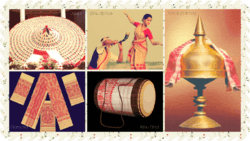Assamese consonant clusters
| Part of a series on the |
| Culture of Assam |
|---|
 |
|
Protohistoric
Ancient Medieval Colonial |
|
|
|
|
|
|
Festivals
|
| Religion |
|
History
Archives
Genres
Institutions Awards Asam Sahitya Sabha Award • Kamal Kumari Foundation Award • Krishnakanta Handique Award |
|
Music and performing arts |
|


Assamese or Asamiya consonant clusters include thirty three pure consonant letters in Assamese alphabet and each letter represents a single sound with an inherent vowel, the short vowel /a /.
The first twenty-five consonants letters are called ‘sparxa barna’. These ‘sparxa barnas’ are again divided into five ‘bargs’. Therefore, these twenty-five letters are also called ‘bargia barna’.
The Assamese consonants are typically just the consonant's main pronunciation plus the inherent vowel ô. The inherent vowel is assumed and not written, thus, names of most alphabets look identical to the letter itself (e.g. the name of the letter ঘ is itself ঘ ghô).
Some letters have lost their distinctive pronunciation in modern Assamese are called by a more elaborate name. For example, since the consonant phoneme /n/ can be written ন, ণ, or ঞ (depending on the spelling of the particular word), these letters are not simply called nô; instead, they are called ন dôntiya nô ("dental n"), ণ murdhôinnya nô ("cerebral n"), and ঞ niô.
Similarly, the phoneme /x/ can be written as শ talôibbya xô ("palatal x"), ষ murdhôinnya xô ("cerebral x"), or স dôntiya xô ("dental x"), the phoneme/s/ can be written using চ prôthôm sô ("first s") or ছ ditiyô sô ("second s"), and the phoneme /z/ can be written using জ bôrgiya zô ("row z" = "the z included in the five rows of stop consonants") or য ôntôsthô zô ("z situated between" = "the z that comes between the five rows of stop consonants and the row of sibilants"), depending on the standard spelling of the particular word.
Classification
The consonant clusters can be arranged in following groups:
Group: 1 - Gutturals
| Consonants | Phonetics |
|---|---|
| ক | kô |
| খ | khô |
| গ | gô |
| ঘ | ghô |
| ঙ | ṅgô |
Group: 2 - Palatals
| Consonants | Phonetics |
|---|---|
| চ | prôthôm sô |
| ছ | ditiyô sô |
| জ | bôrgiya ja |
| ঝ | jhô |
| ঞ | ñiô |
Group: 3 - Cerebrals
| Consonants | Phonetics |
|---|---|
| ট | murdhôinnya ṭa |
| ঠ | murdhôinnya ṭha |
| ড | murdhôinnya ḍa |
| ড় | daré ṛa |
| ঢ | murdhôinnya ḍha |
| ঢ় | dharé ṛha |
| ণ | murdhôinnya ṇa |
Group: 4 - Dentals
| Consonants | Phonetics |
|---|---|
| ত | dôntiya ta |
| ৎ | khanda ṯ |
| থ | dôntiya tha |
| দ | dôntiya da |
| ধ | dôntiya dha |
| ন | dôntiya na |
Group: 5 - Labials
| Consonants | Phonetics |
|---|---|
| প | pa |
| ফ | pha |
| ব | ba |
| ভ | bha |
| ম | ma |
Group: 6 - Semi-vowels
| Consonants | Phonetics |
|---|---|
| য | ôntôsthô zô |
| য় | ôntôsthô ẏô |
| ৰ | ra |
| ল | la |
| ৱ | wa |
Group: 7 - Sibilants
| Consonants | Phonetics |
|---|---|
| শ | talôibbya xô |
| ষ | mudhôinnya xô |
| স | dôntiya xô |
Group: 8 - Aspirate
| Consonants | Phonetics |
|---|---|
| হ | ha |
| ক্ষ | khyô |
Group: 9 - Anuxāra
| Consonants | Phonetics |
|---|---|
| ং | ṃ anuxar |
Group: 9 - Bixarga
| Consonants | Phonetics |
|---|---|
| ঃ | ḥ bixarga |
Group: 10 - Candrabindu (anunāsika)
| Consonants | Phonetics |
|---|---|
| ঁ | n̐, m̐ candrabindu |
- The alphabets শ (talôibbya xô), ষ (murdhôinnya xô), স (dôntiya xô) and হ (hô) are called “usma barna”
- The letters য (za), ৰ (ra), ল (la) and ৱ (wa) are called “ôntôsthô barna”
- The letters ড় (daré ṛa) and ঢ় (dharé ṛha) are phonetically similar to /ra /
- The letter য (ôntôsthô zô) is articulated like “'ôntôsthô yô'” in the word medial and final position. To denote the “ ôntôsthô ẏô” the letter য় (ôntôsthô ẏô) is used in Assamese
- ৎ (khanda ṯ) means the consonant letter Tö (dôntiya ta) without the inherent vowel
Halant
To write a consonant without the inherent vowel the halant sign is used below the base glyph. In Assamese this sign is called ‘haxanta’.
Consonant Conjuncts
In Assamese, the combination of three consonants is possible without their intervening vowels. There are about 122 conjunct letters. A few conjunct letters are given below:
Anuxôr
Anuxôr ( ং ) indicates a nasal consonant sound (velar). When an anuxar comes before a consonant belonging to any of the 5 bargas, it represents the nasal consonant belonging to that barga.
Candrabindu
Chandrabindu ( ঁ ) denotes nasalization of the vowel that is attached to it .
Bixargô
Bixargô ( ঃ ) represents a sound similar to /h /.
References
- ↑ "Meet the Axomiya Sikhs". The Tribune. Chandigarh. 24 March 2013.